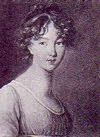 This sounds like a comfortable little project, all plump and
homley and just the thing to whip up in an evening or two.
This sounds like a comfortable little project, all plump and
homley and just the thing to whip up in an evening or two.
So it should have been but it was just the opposite.
I rarely dislike things that I make or do not enjoy the
process of making them. Some projects can be boring in repetition of stitches
or frustrating in some aspect of gauge and its results or deadlines but I
usually soldier on and have never really abandoned a project simply out of
dislike. Lately, however, there have been two which have qualified in this
category. This tea cosy and another one which, I expect, will eventually show
up on this blog, have tormented me for years. They have been started,
consequently, quite a few times, with different yarns, needles, and attitudes,
and finally, in this Year of Completion, abandoned no more but finished. One of
them, at least; the other one is still a wip, continuing to drive me mad.
Thw pattern comes from Weldon’s
Practical Knitter, Number 84, Twenty-First Series (1892). It is also published
in Weldon’s Practical Needlework, Volume 7, Interweave Press, 2002.
The original pattern
for this “charming tea cosy” calls for “double Berlin wool for the outside of
the cosy” and “single Berlin for the inside or lining” as well as “a pair of
No. 4 and a pair of No. 6 bone or wood knitting needles (modern equivalents
5.50mm/US 9 and 4.50mm/US 7) and 1 ½ yards of inch-wide pink ribbon for
trimming.” The exterior is knit in brioche stitch and the interior in “plain
knitting” (stockinette), two pieces of each that are sewn together and then those sewn together with openings at the seams for the handle and spout. The colours “gobelin blue”
and “salmon” were suggested in the pattern.
It all sounds very
straightforward. The trouble began with the yarn. My first two attempts were
with two strands of crewel-weight wool for the blue part which produced a lacy
rather than that squashy pillow-like effect of the brioche stitch. When I next
returned to the project, a few years later, I used two whole strands of
Appleton tapestry/needlepoint wool which, with two strands produced a knitted
fabric that was too rigid – the complete opposite of the first attempt. I
finally settled on KnitPicks’ Palette (two strands at once) taking “Berlin
wool” as a suggestion of weight rather than type. I tried out several shades of
blue before I settled on one called Blue.
Since “salmon” was mentioned
for the pink section in the pattern, I began a quest for that shade and
KnitPicks’ Peony came closest to that.
The nightmare, unfortuately, continued with the Brioche stitch and it only got worse. I have always
liked the look of that stitch but I just don’t enjoy knitting it. I have been
making Arans since my early teens and knitted lace for many decades so Brioche
should have been a piece of cake. I have, however, never made so many mistakes or,
rather, messed up the stitches even when I was counting and examining my work
and missed the mistakes until it was too late and I was, uncharacteristically,
past caring. The edges, with the YO at the beginning of the row made such a
ragged mess that I added an extra stitch at both ends, slipping the first
stitch of each row and knitting or purling the last of the first piece. That
made even more of a mess of the edges so for the second piece, I knit those
extra stitches which looked a bit better but not much. A few mysterious holes
appeared in the main body of the blue sections and I knit and ripped them both
several times wondering how it could take me so long to knit two pieces that
only measure 9” wide by 7” high. The
pink pieces were a relief, easily knit in an hour or so, and made an inch longer
than the blue ones to create the upper frill.
The top was finished by running “ a drawing thread through
the cast-off stitches of the blue” section, adding “a piece of ribbon round,
making a handsome bow in front and a smaller bow behind” and (my favourite
sentence in the pattern), pulling “out the pink frill at the top of the cosy to
the best advantage.”
All I can say is that the best advantage is that it is knit
at last. Even a few hours spent at 165 Eaton Place (Series One and Two) and
taking good looks at the teapots in their cosies on the downstairs’ table was not enough solace to accompany the recent knitting of this unfortunate project.
It may still have holes and uneven knitted and sewn edges, and look like
something I might have made when I was ten years old but it is finally off the
needles once and for all!




3 comments:
Nineteenth century instructions appear to be more "guidelines" than rules. Similarly, the engravings occasionally appear to be fever-dreams if not actually affected by opium use. Congratulations on a finished object!
A most apt description of the engravings! I sometimes think I will go mad trying to exactly reproduce some of the images!
Appreciate your blogg post
Post a Comment